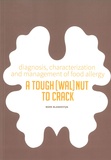Diagnosis, characterization and management of food allergy
a tough (wal)nut to crack

Blankestijn, Mark
- Promoter:
- Prof.dr. A.C. (André) Knulst & prof.dr. G.F. (Geert) Houben
- Co-promoter:
- Dr. R.J.B. (Rob) Klemans & dr. H.G. (Henny) Otten
- Research group:
- Knulst
- Date:
- December 12, 2017
- Time:
- 10:30 h
Summary
Walnut (Juglans regia) is a known food allergen, able to elicit potentially severe allergic reactions. Threshold data from walnut challenged and allergic adults demonstrated that walnut is a potent allergen, with eliciting doses similar to hazelnut. Walnut 2S albumin Jug r 1 was the dominant walnut allergen in our walnut allergic population, but assessing sensitization to walnut extract performed similar in diagnosing walnut allergy. Walnut 11S globulin Jug r 4 appeared to be an allergen recognized by a subset of walnut allergic subjects, however sensitization was strongly associated with walnut allergy.
Evaluating (co-)sensitization to other tree nuts and peanut in walnut allergic adults revealed that sensitization to pecan and hazelnut is very common, although it might not always be clinically relevant. Proper evaluation of all tree nuts could prevent unnecessary avoidance and broaden the diet of tree nut allergic individuals.
In peanut challenged adults, specific IgE (sIgE) against peanut 2S albumin Ara h 7 was found to be as discriminative for peanut allergy as sIgE to the other 2S albumins, Ara h 2 and 6. Mono-sensitization occurred to either Ara h 2, 6 and 7 in a small subset and leads to a risk of misdiagnosis when testing for a single 2S albumin only.
Multiplex sIgE testing of adults with a suspected food allergy demonstrated that sensitization to birch-pollen related PR-10 proteins can occur in different phenotypes: the PR-10 proteins from soy, celery and kiwi were less frequently recognized than others and appeared to be an indication of polysensitization. Additionally, a subset of individuals recognized PR-10 food proteins without concomitant sensitization to pollen allergen from the PR-10 protein family, potentially indicating direct sensitization to these proteins.
In a pilot study, daratumumab reduced total and specific IgE levels in a patient treated for multiple myeloma. This therefore warrants further research as potential treatment option for IgE-mediated allergic diseases.